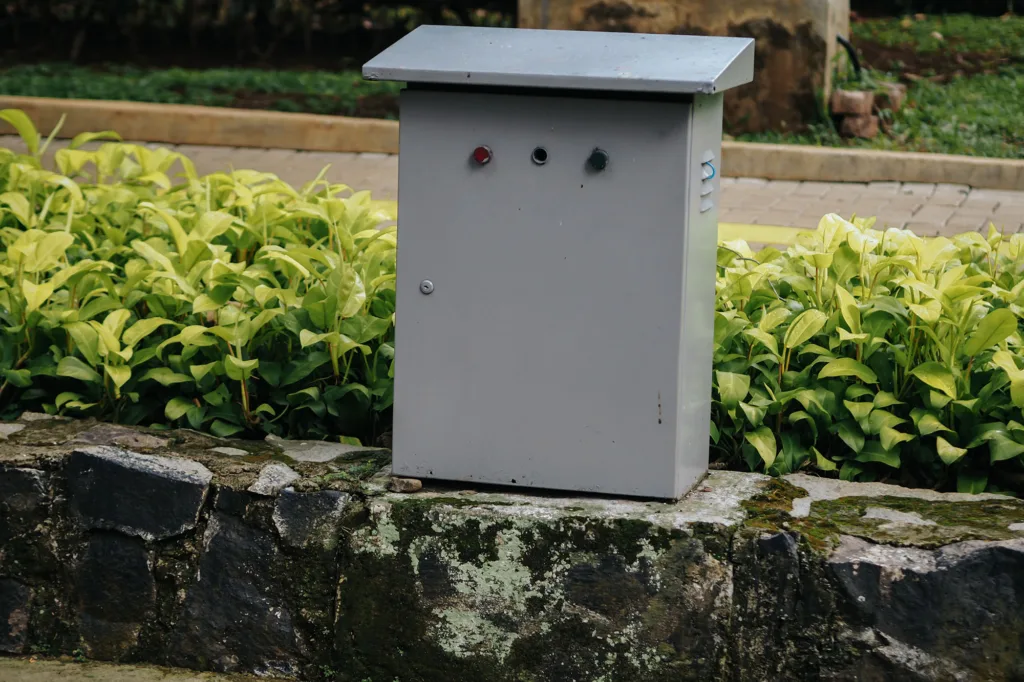Outdoor lighting can completely transform your garden, making it an inviting space even after sunset. But, to make sure your lighting works efficiently and safely, especially with low-voltage systems, you’ll need the right transformer. In Cornwall, where the weather can be unpredictable, understanding how to wire lighting transformers properly is essential. From enhancing the aesthetics of your outdoor space to ensuring a smooth installation, this guide will take you through the practical steps for wiring garden lighting transformers.
Understanding Lighting Transformers for Garden Use
What is a Lighting Transformer?
A lighting transformer is essential for low-voltage garden lights. It converts the 230V mains electricity supply to the lower voltage required by most garden lights, typically 12V or 24V. This ensures your lighting operates safely and efficiently. Transformers also prevent your lights from receiving too much voltage, which could damage them.
Without a transformer, trying to power a 12V system with 230V electricity would burn out your lights in an instant—not ideal when you’re aiming to create a peaceful garden retreat!
For more on basic electrical concepts related to transformers and wiring, take a look at our detailed guide on Understanding Electrical Symbols.
Why Do Garden Lights Need Transformers?
Most outdoor lights designed for UK gardens, like MR16 or LED strip lights, operate at low voltages. These lighting systems require a transformer to step down the standard 230V to either 12V or 24V. Transformers play a key role in ensuring safe and long-lasting operation of your lights, protecting them from voltage spikes and other electrical issues. Plus, a correctly wired transformer prevents overheating, thus prolonging the lifespan of your lights.
Whether you’re installing path lights or uplighting a feature tree, the transformer is the backbone of your garden’s lighting infrastructure.
Steps to Wire a Lighting Transformer in Your Garden
Materials and Tools Needed
Before getting started, make sure you have the right tools and materials. Here’s a checklist:
- Transformer suited for outdoor use
- Low-voltage garden lights (e.g., LED MR16)
- Outdoor-rated electrical cable
- Wire strippers and cutters
- Screwdrivers
- Waterproof junction box (optional)
- Electrical tape or heat-shrink tubing for sealing connections
- Multimeter (for testing voltage)
Step-by-Step Wiring Instructions
1. Plan the Layout
Decide where your transformer will be located—this should be near an outdoor socket but away from direct rain or splashes. Consider using a waterproof enclosure for added protection.
2. Connecting the Transformer
Start by switching off the power at the mains. Mount the transformer securely, ensuring it’s protected from the elements. Follow the manufacturer’s instructions to wire the primary input terminals to your mains supply. Use suitable weatherproof connectors if necessary.
3. Wiring the Lights to the Transformer
Measure the distance from the transformer to each light. Use outdoor-rated low-voltage cables to connect your lights. Connect the output terminals of the transformer to the lighting circuit, ensuring the polarity is correct. Secure all connections using waterproof tape or junction boxes to avoid moisture ingress.
4. Final Safety Checks
Once the wiring is complete, double-check all connections. Use a multimeter to confirm that the voltage output from the transformer matches your light’s specifications (typically 12V or 24V). If everything looks good, switch the mains power back on and test your lights.
Best Practices for Safe Wiring
Wiring outdoor lights in Cornwall requires special attention to weather conditions. Cornwall’s wet climate means your wiring needs to be particularly well-protected from water exposure. Use waterproof connectors and bury cables underground where possible to prevent accidental damage from gardening tools.
For more on safe installation practices and outdoor lighting systems, check out our Outdoor Electrics Services.
Choosing the Right Transformer for Your Garden Lights
Matching Transformer Load with Lighting Requirements
Choosing the right transformer involves calculating the total wattage of all the lights in your system. Add up the wattage of each light and select a transformer with a capacity 20-30% higher than this total. This extra margin accounts for any future additions to your garden lighting and prevents overloading.
For example, if you have five 5W LED lights, your total wattage is 25W. In this case, a 40W transformer would be a good choice.
Incorrectly sizing your transformer can lead to flickering or buzzing lights, as low loads on high-capacity transformers often cause such issues. Likewise, overloading your transformer may cause it to overheat, cutting the lifespan of both your lights and the transformer.
Types of Transformers for Garden Lights
Garden lighting transformers come in two main types:
- Magnetic Transformers: These are generally more robust and can handle higher wattages. They’re commonly used in commercial settings but are sometimes bulkier and less energy-efficient.
- Electronic Transformers: Smaller and more energy-efficient, electronic transformers are better suited for residential garden lighting. However, they have stricter minimum load requirements and may not perform well with dimmable lights.
Ensuring Compliance with UK Electrical Regulations
Outdoor electrical work is subject to specific safety regulations in the UK. When installing garden lighting, it’s crucial to comply with Part P of the Building Regulations, which governs electrical installations in outdoor spaces. Any work near water features or ponds requires particular care, as these areas are more prone to electrical hazards.
For detailed regulations, refer to the UK’s Planning Portal or consult a certified electrician to ensure compliance.
Frequently Asked Questions
Do I need a transformer for all garden lights?
Not all garden lights need transformers. Low-voltage lights such as MR16 LEDs do require them, while 230V systems do not. Always check the voltage rating of your lights before deciding.
How can I prevent my lights from flickering?
Flickering usually occurs when the transformer isn’t matched properly with the total wattage of the lights. Ensure that the transformer’s load rating fits the combined wattage of all lights in your system.
Can I install the transformer myself, or should I hire a professional?
While small DIY installations are possible, it’s advisable to hire a qualified electrician for any work involving mains electricity to ensure compliance with UK safety regulations.
Conclusion and Additional Tips
Installing garden lighting transformers is key to ensuring the beauty and functionality of your outdoor space. With proper transformer selection and careful wiring, your garden will remain illuminated year-round, no matter Cornwall’s famously damp weather. Remember to calculate your total wattage and choose a transformer with adequate capacity to avoid issues like flickering. For additional peace of mind, consider hiring a professional to handle the more technical aspects of the installation.
For expert assistance with your garden lighting, reach out to us at Wave Electrical Solutions.










